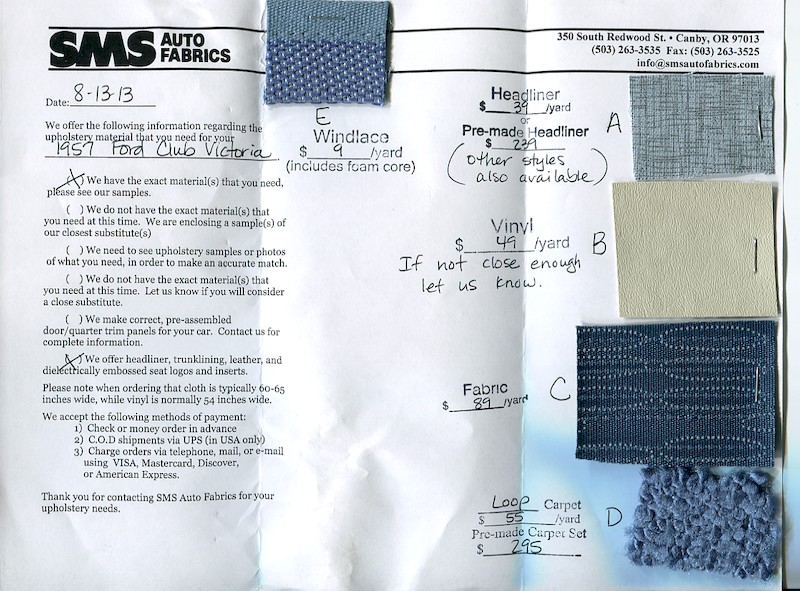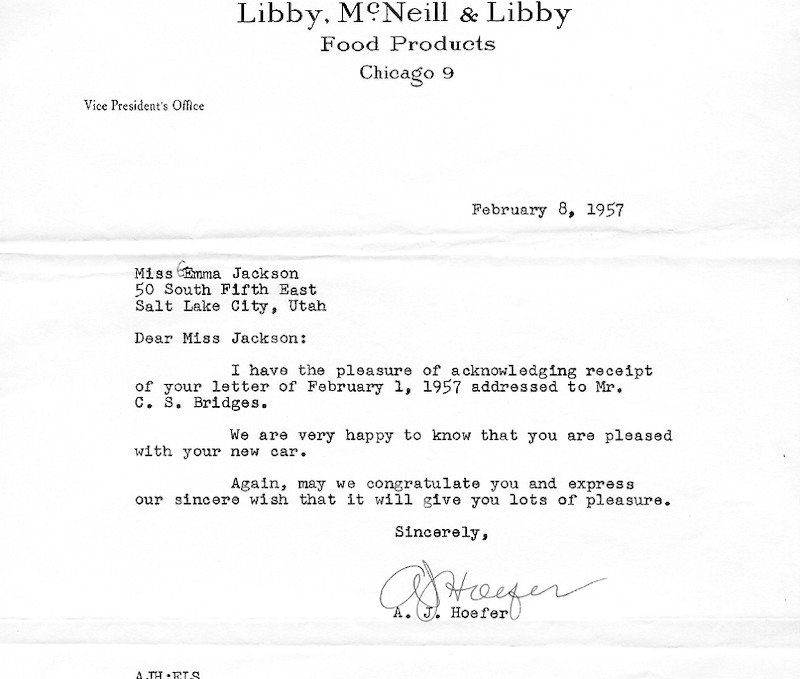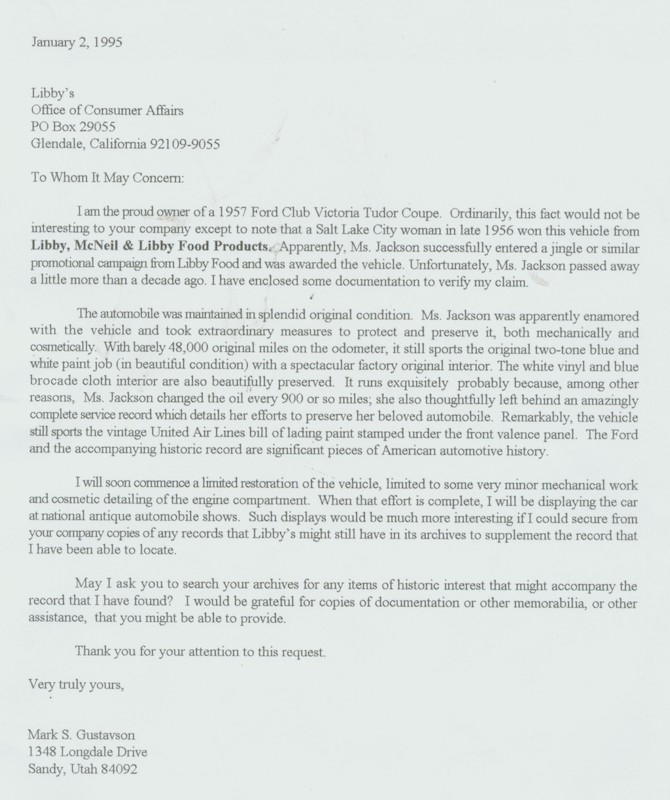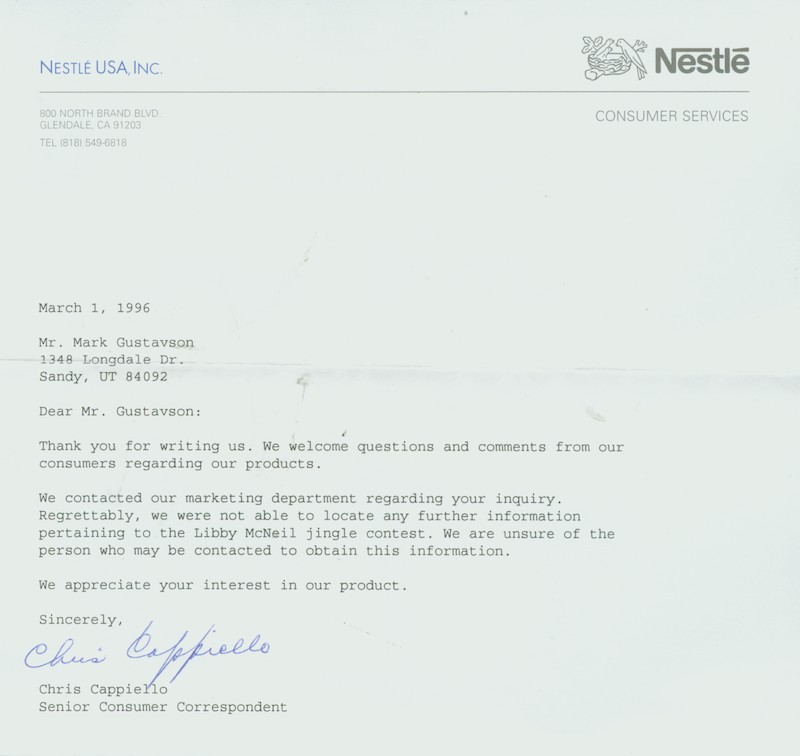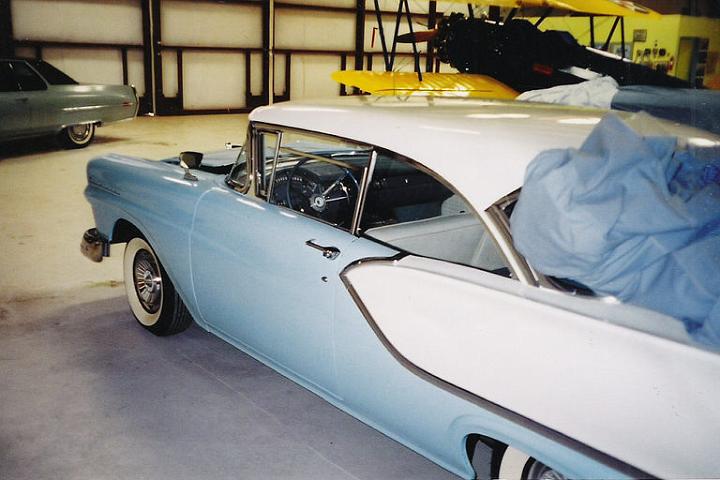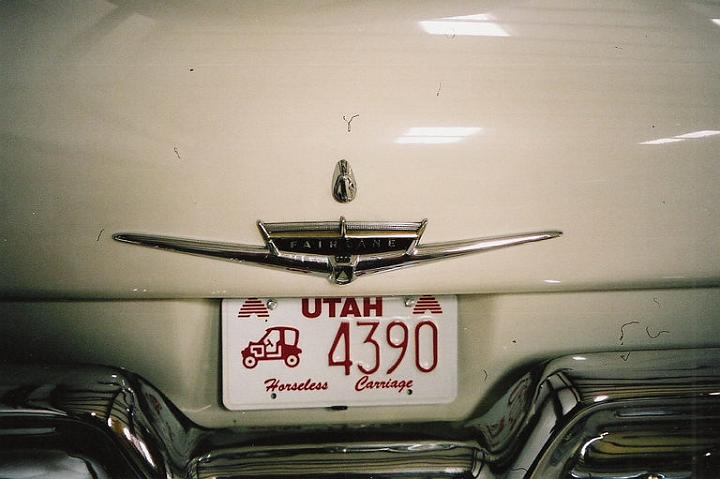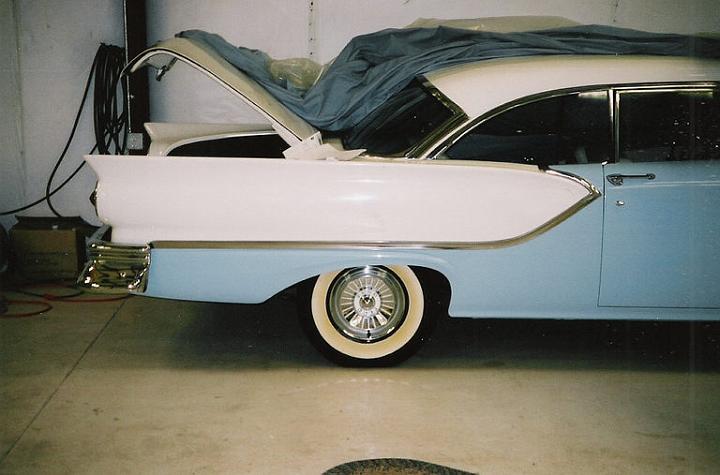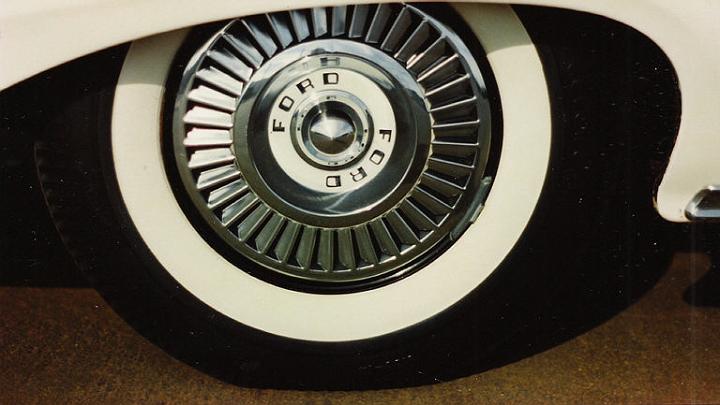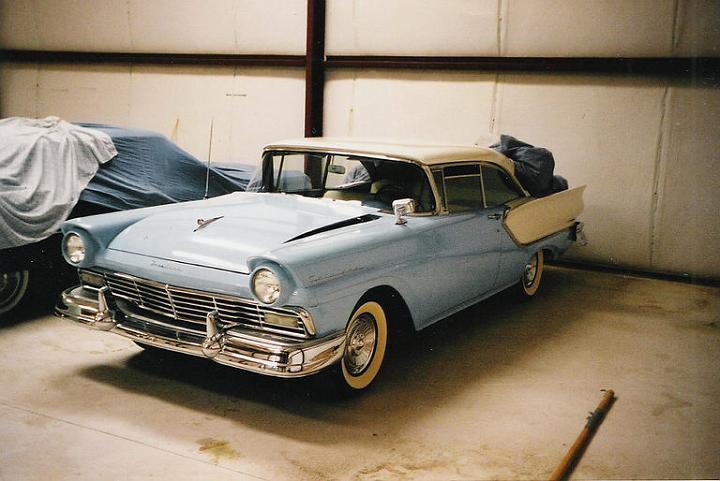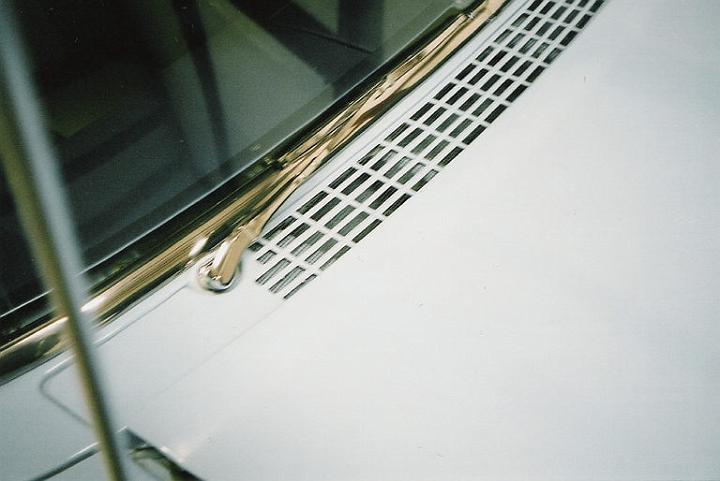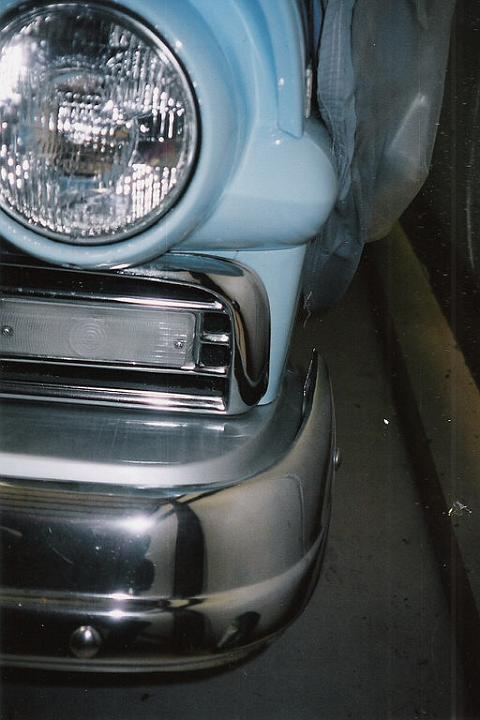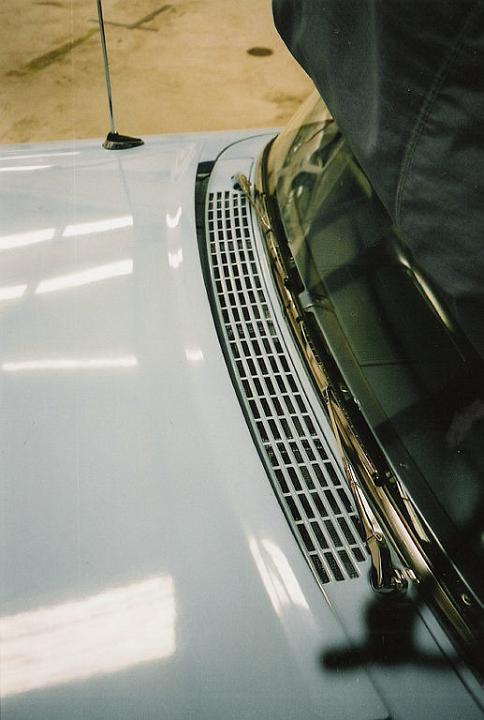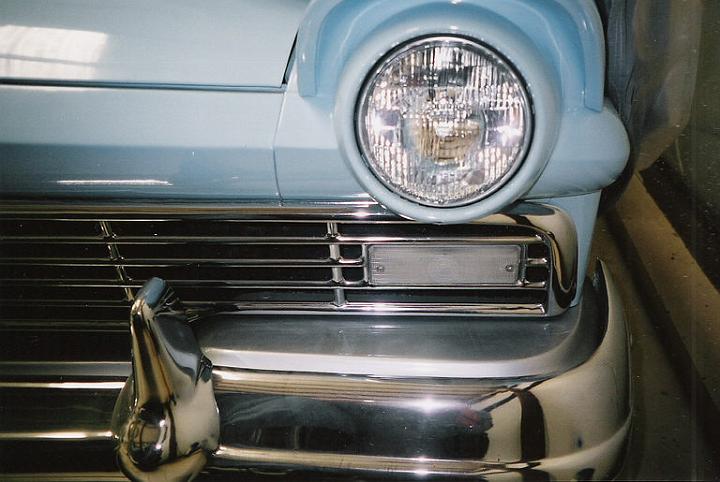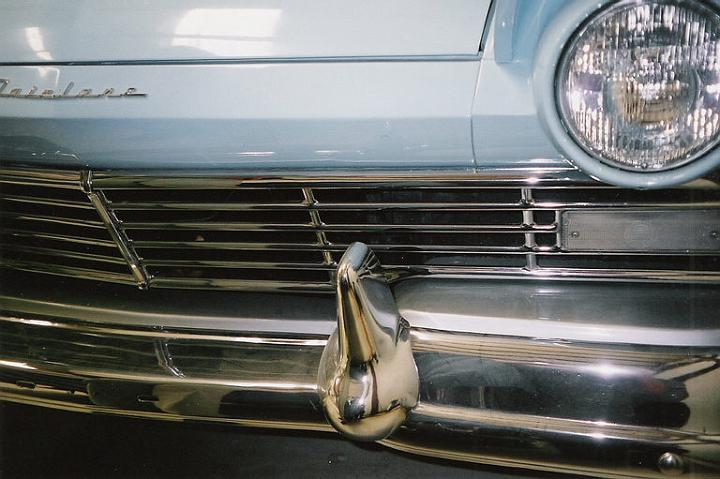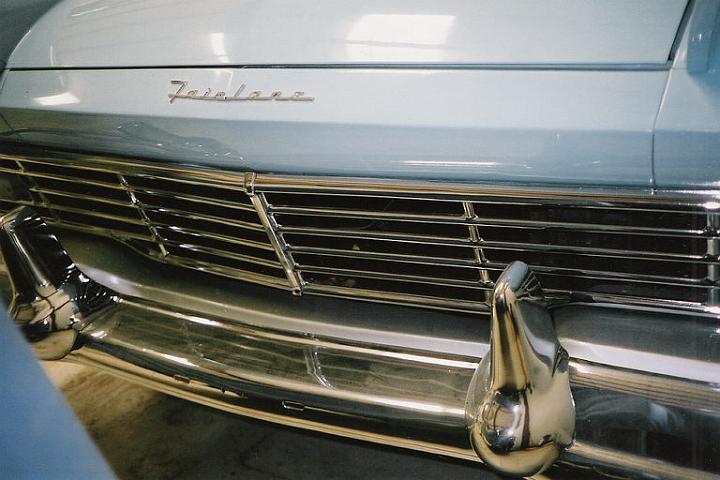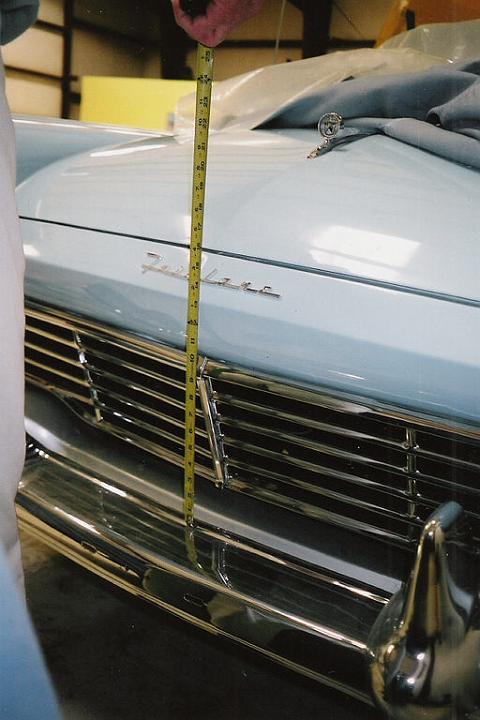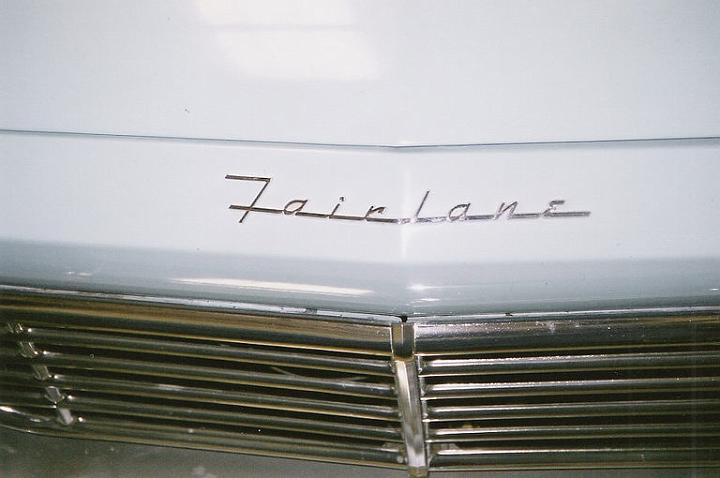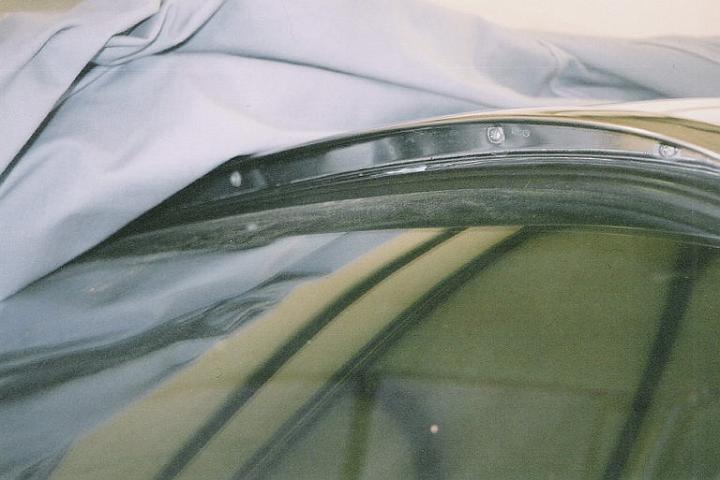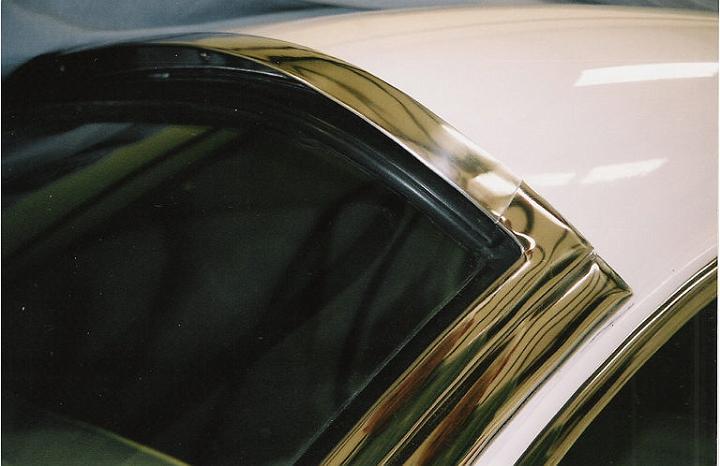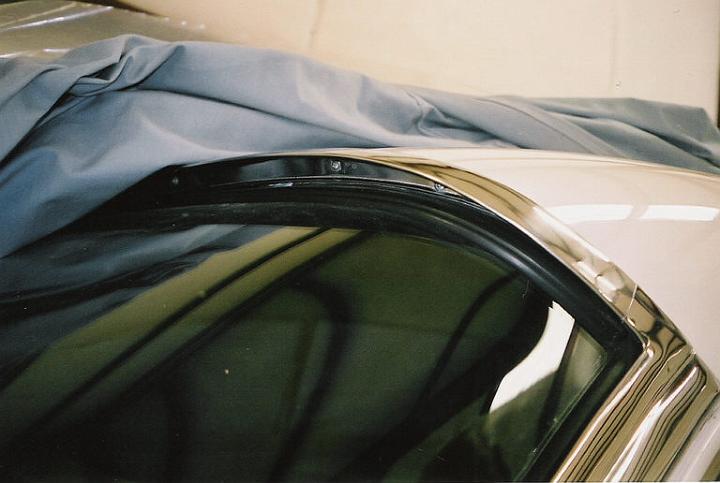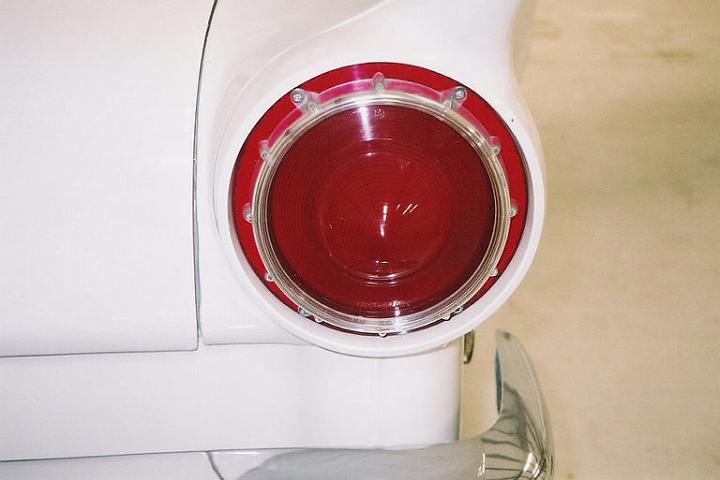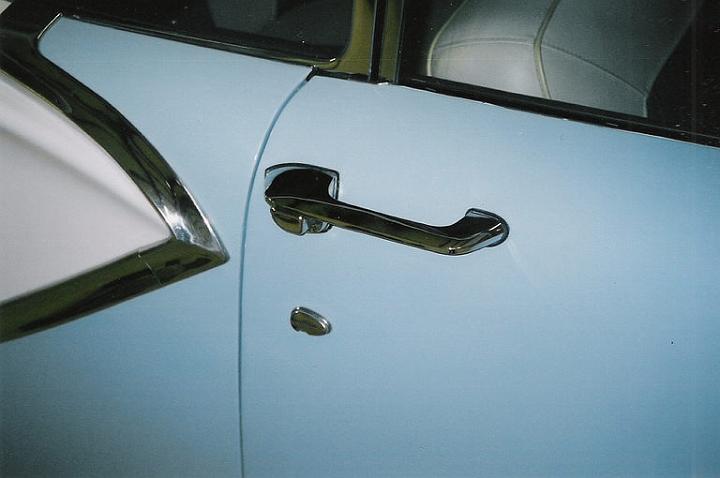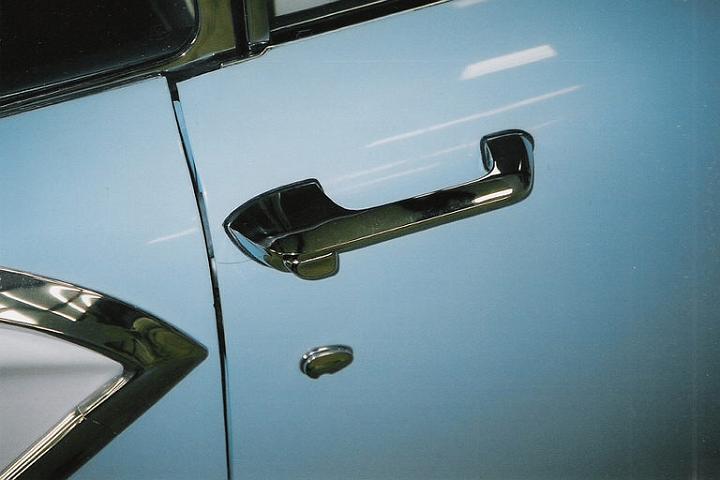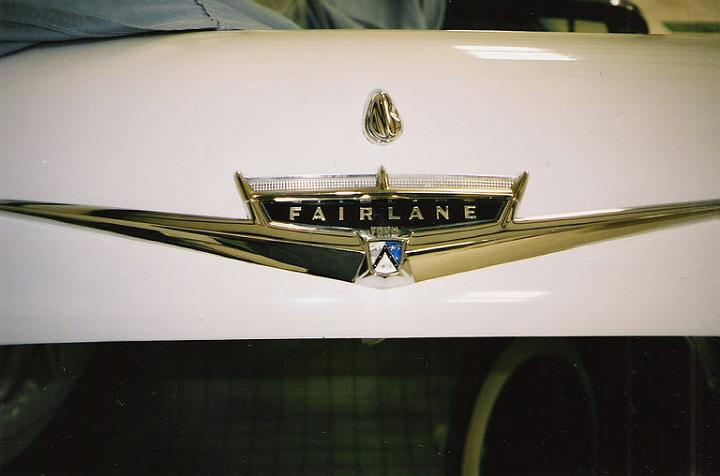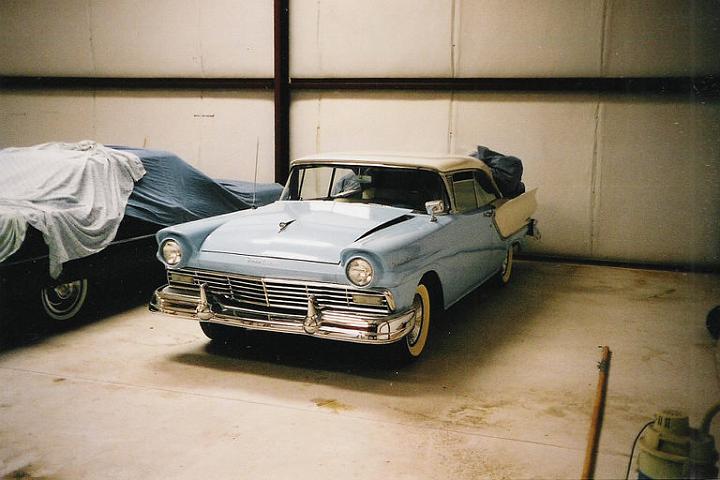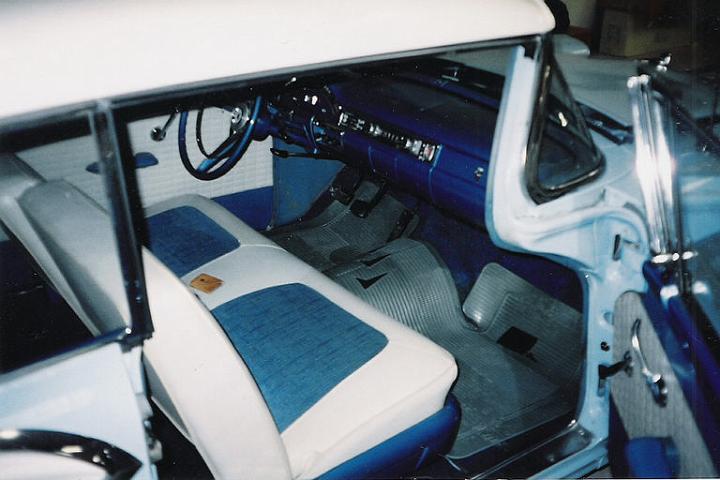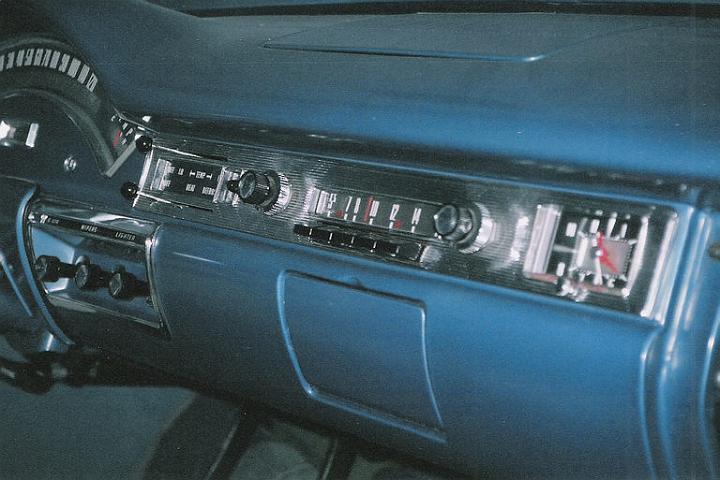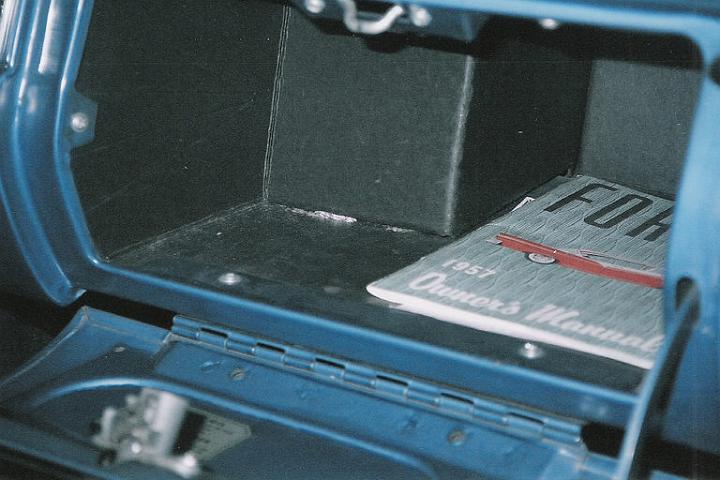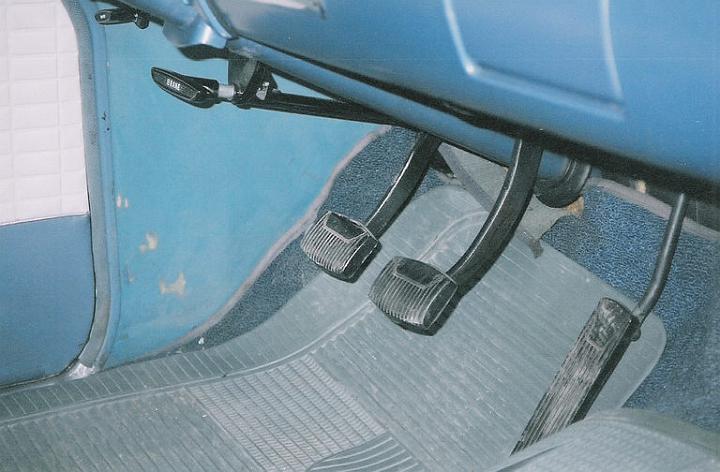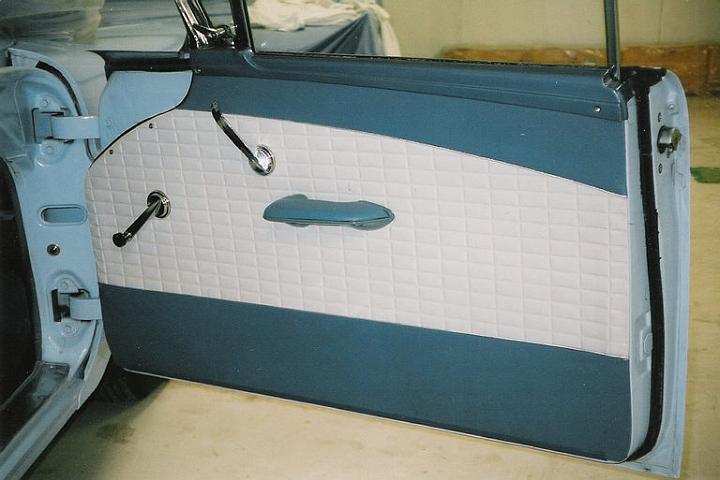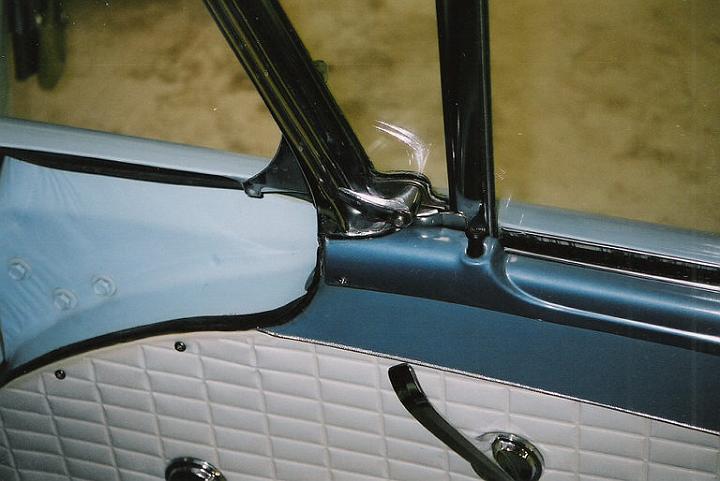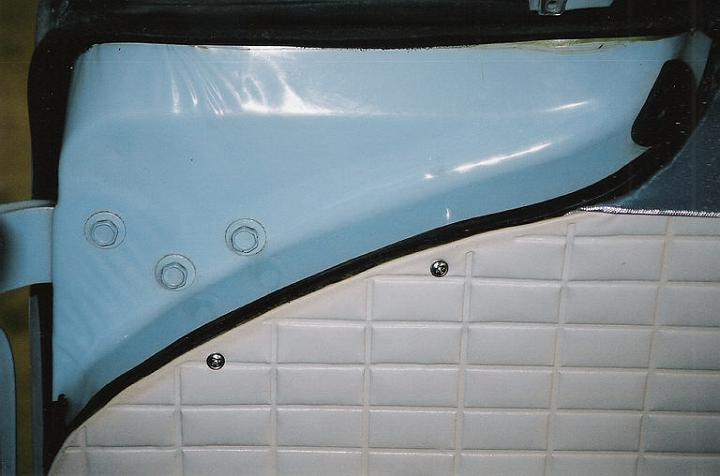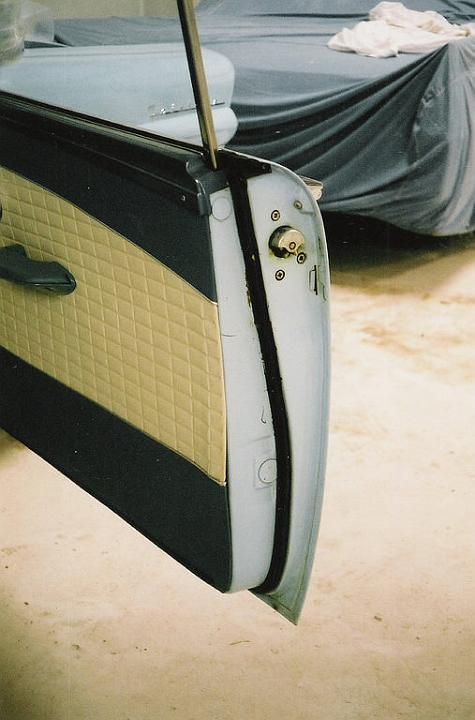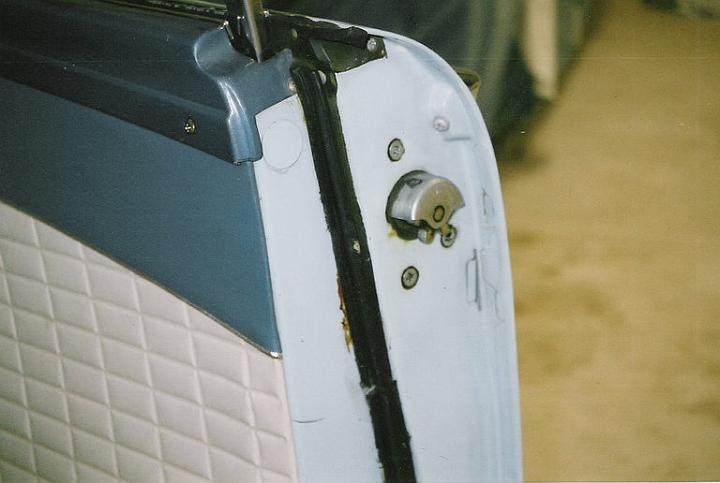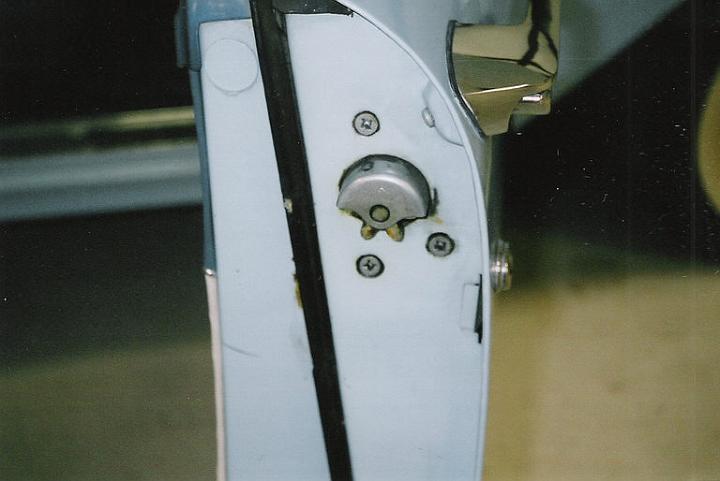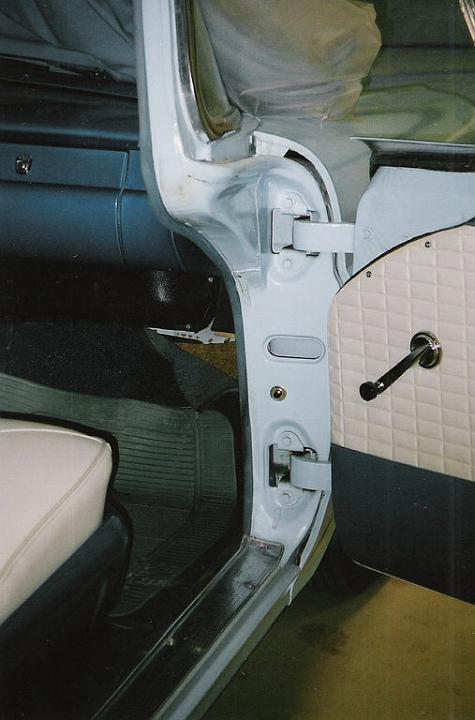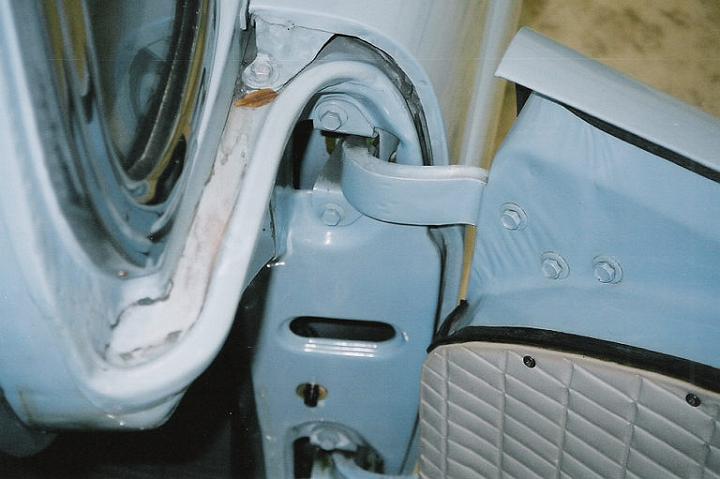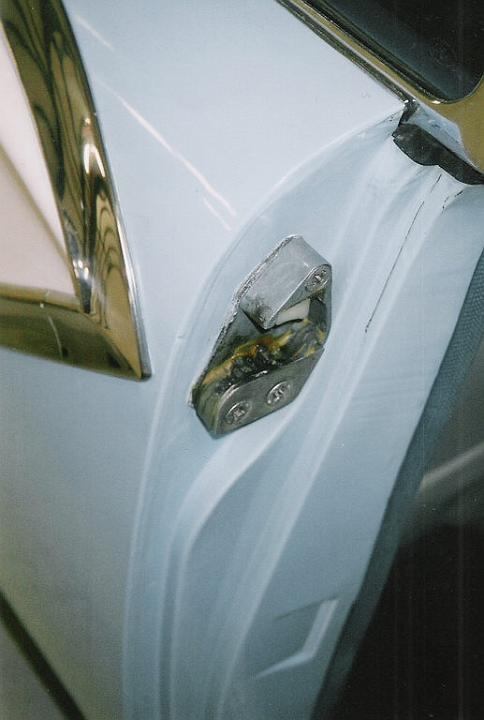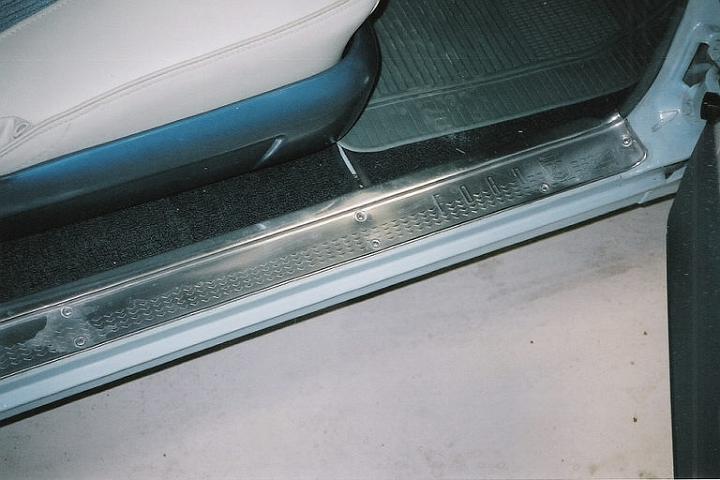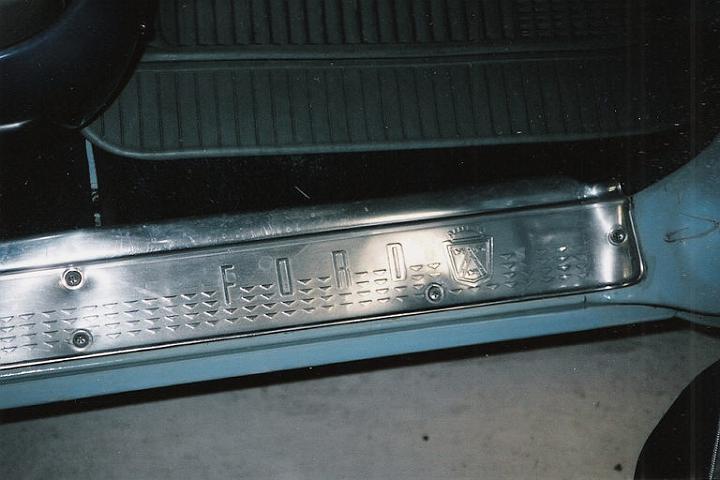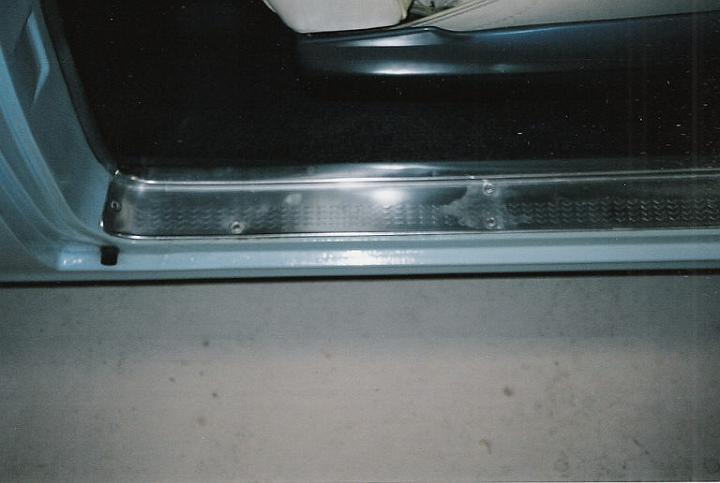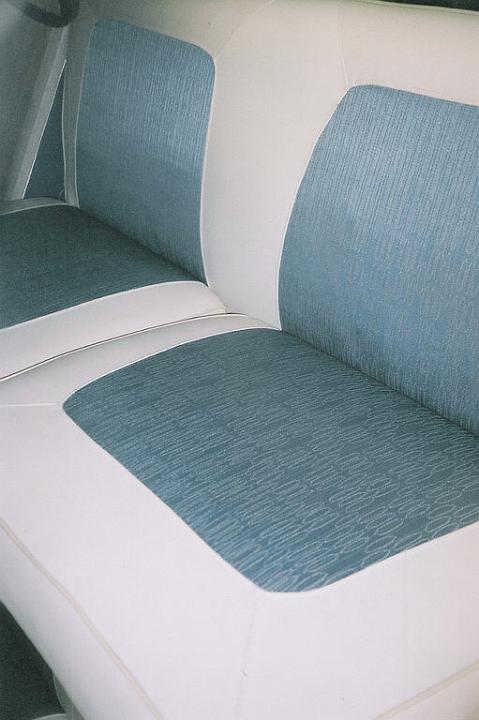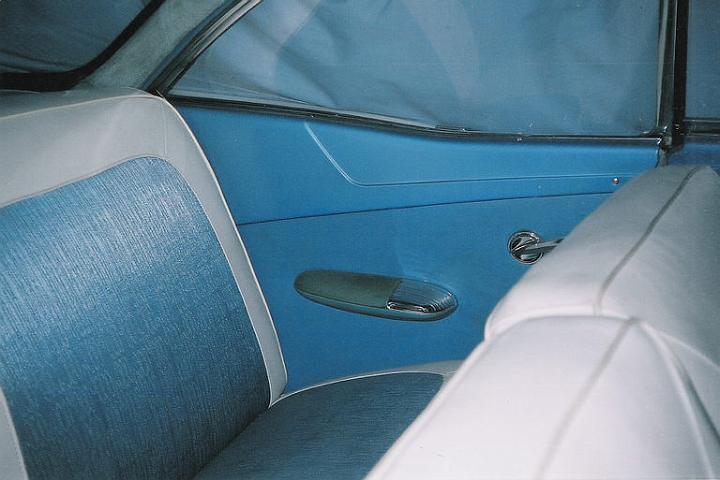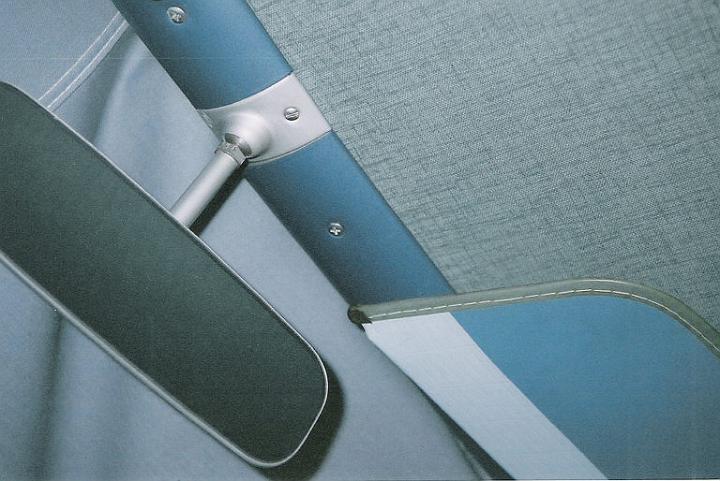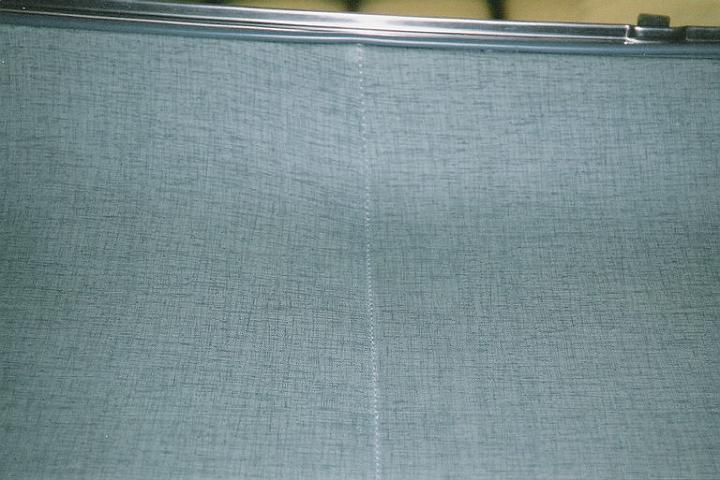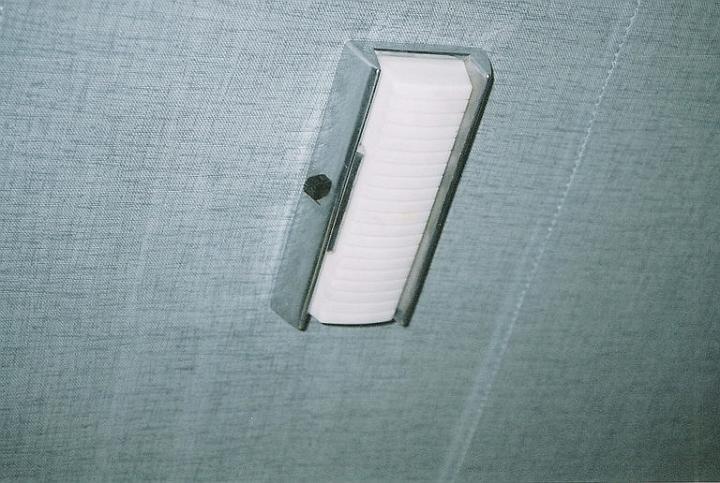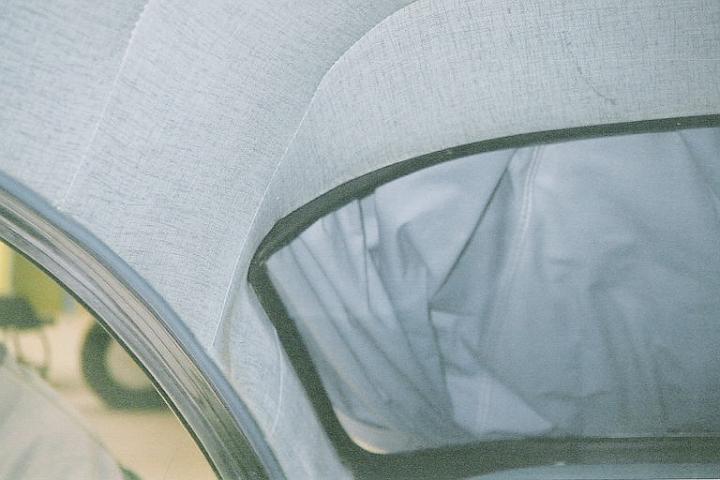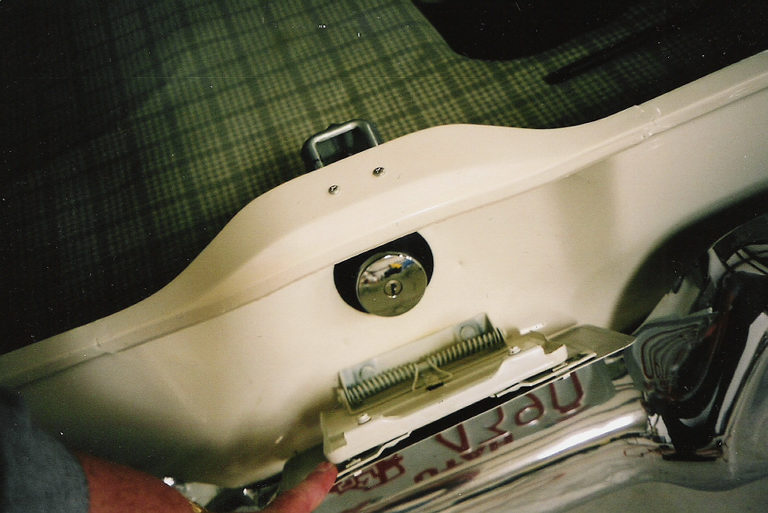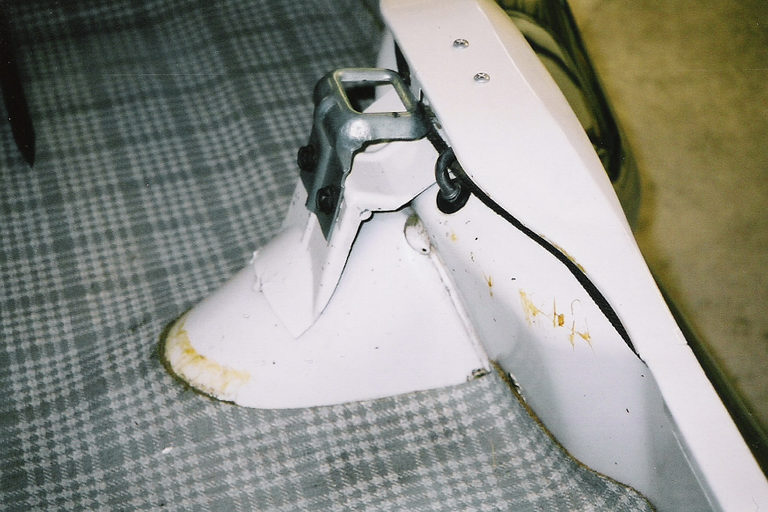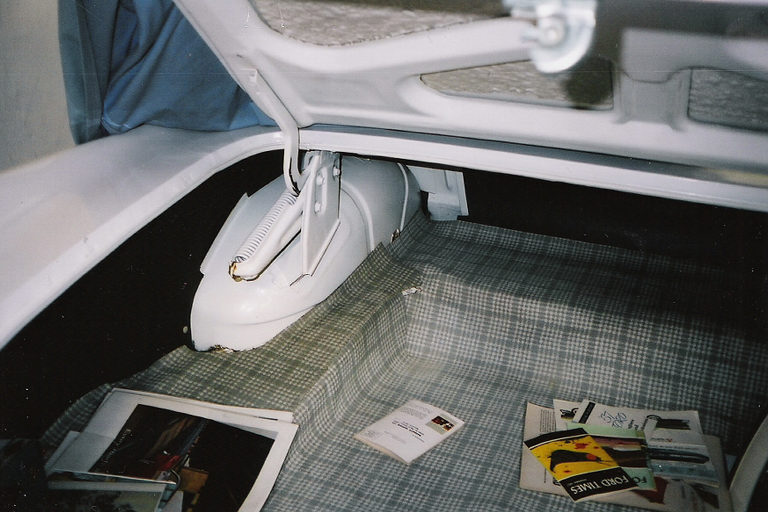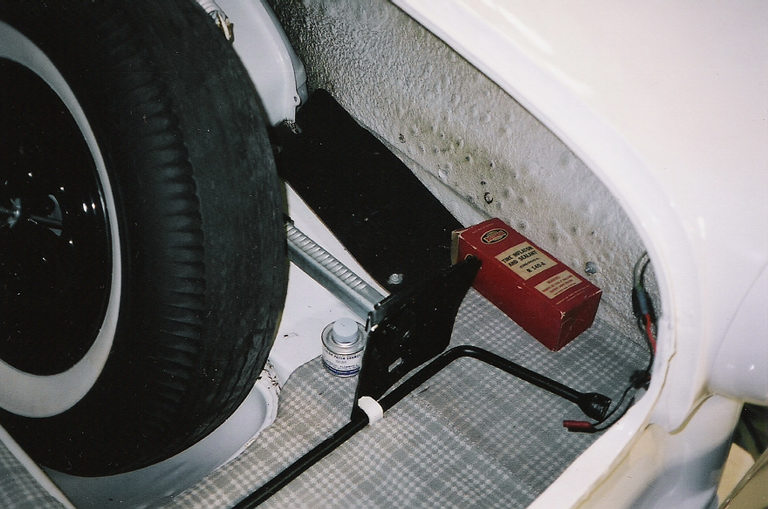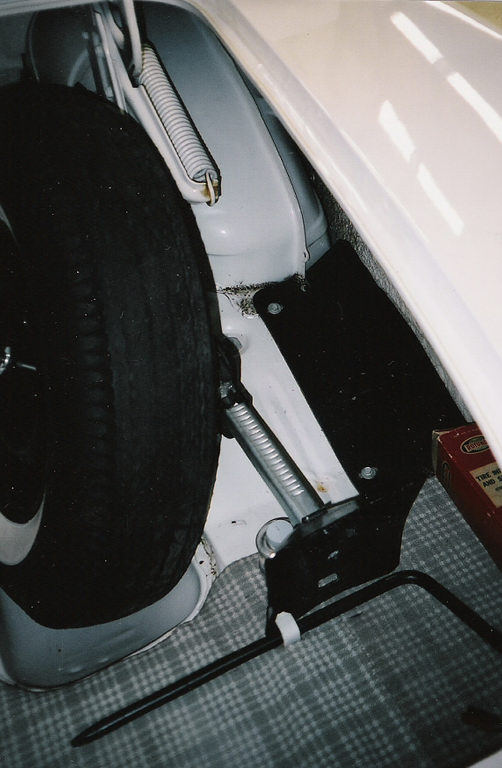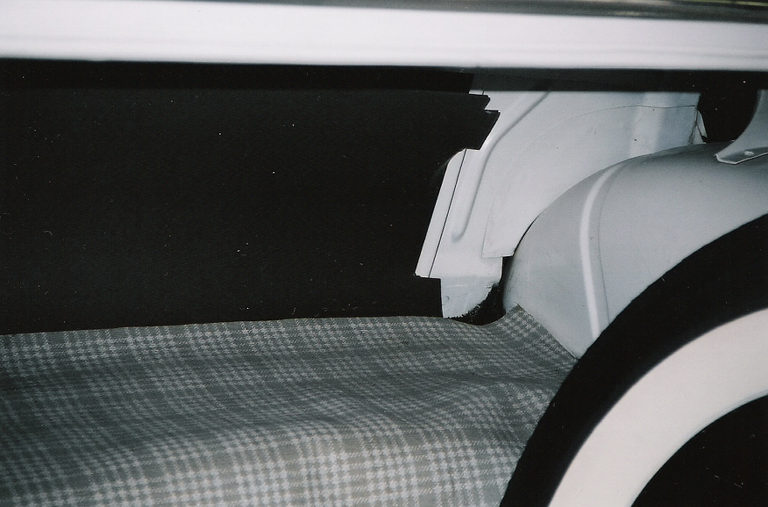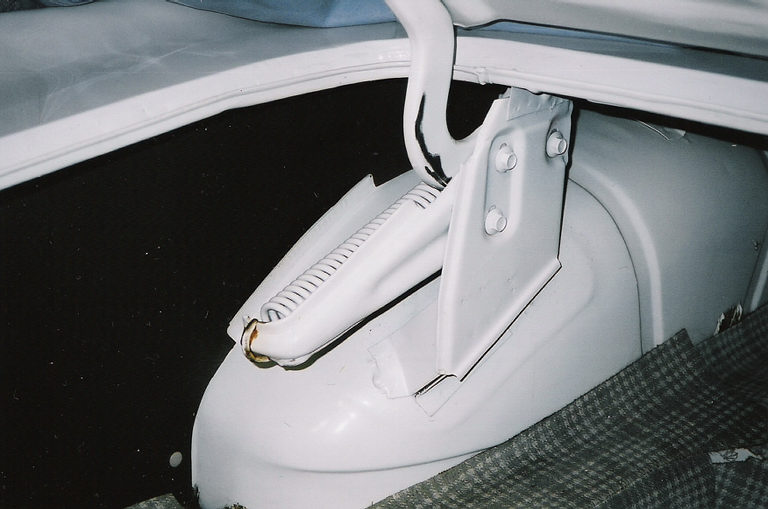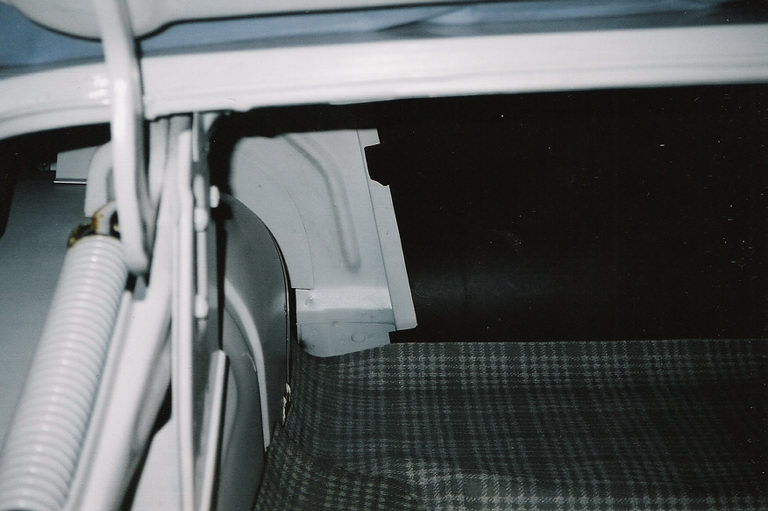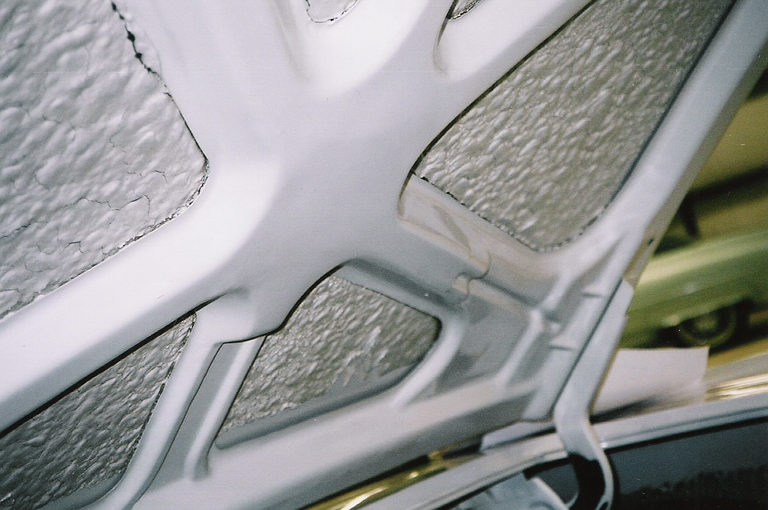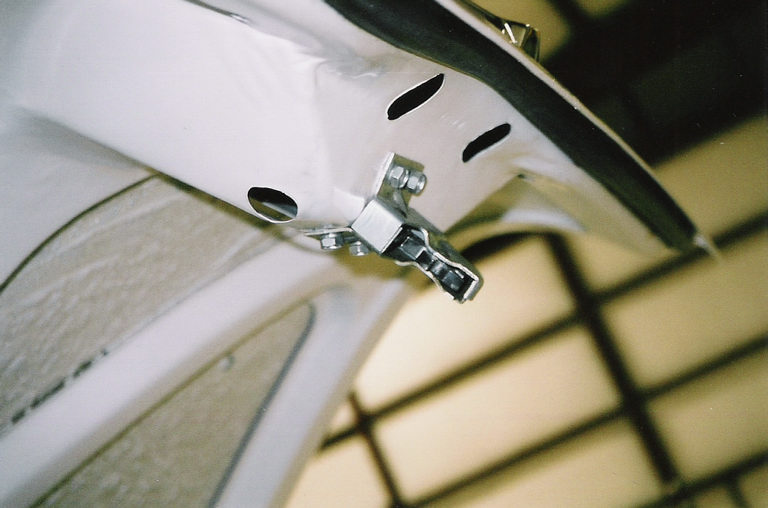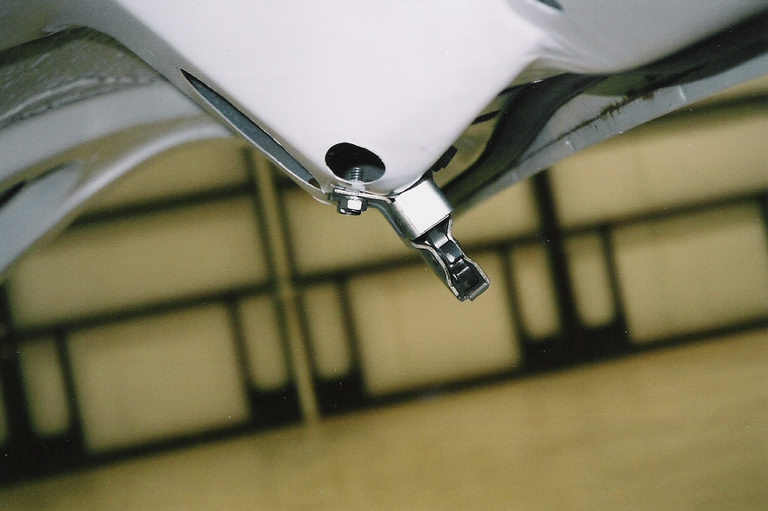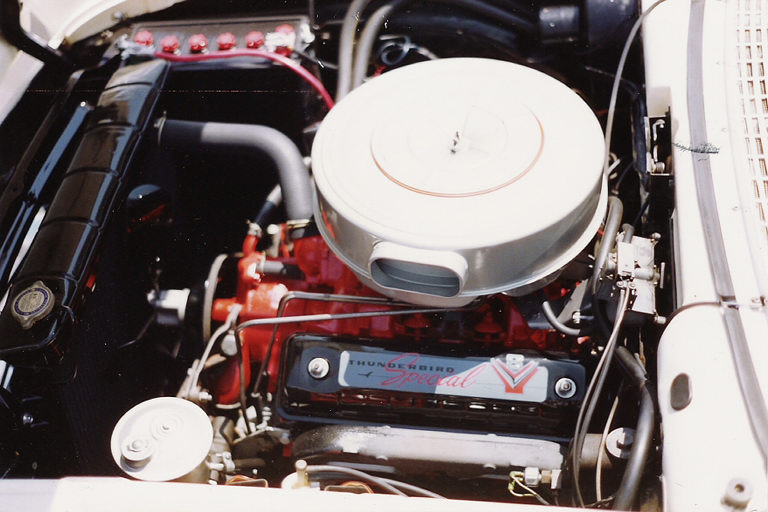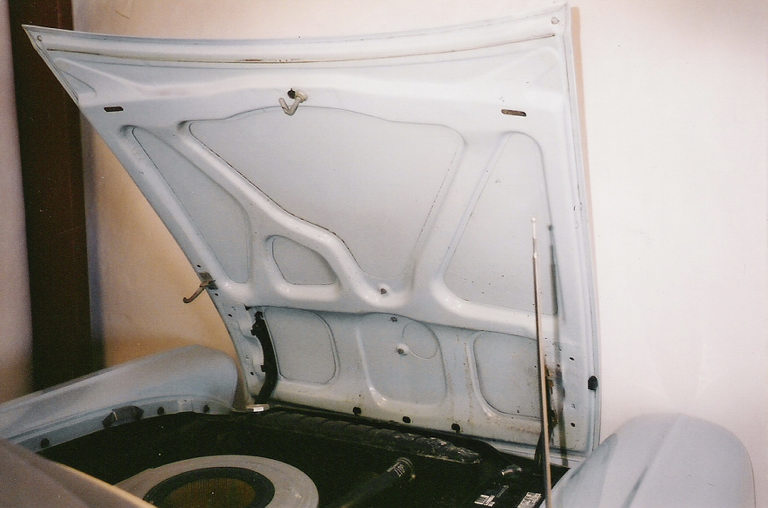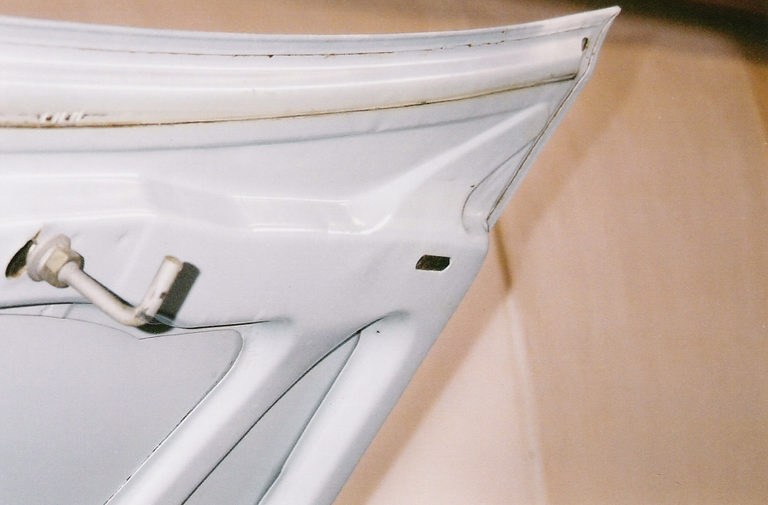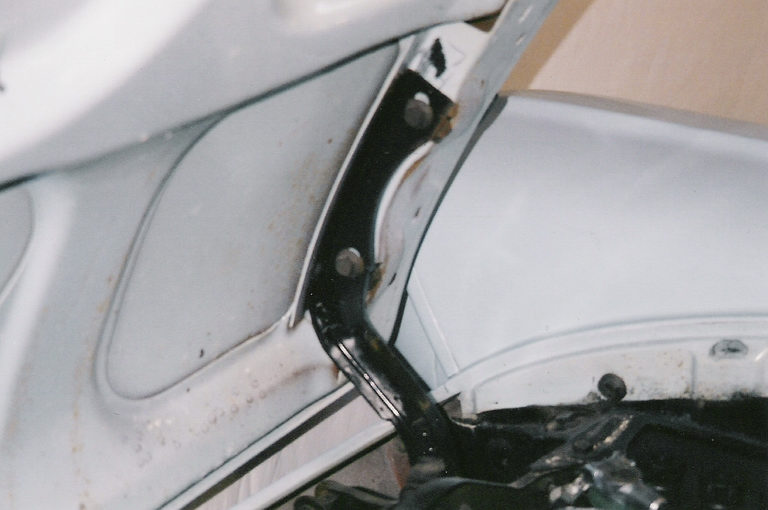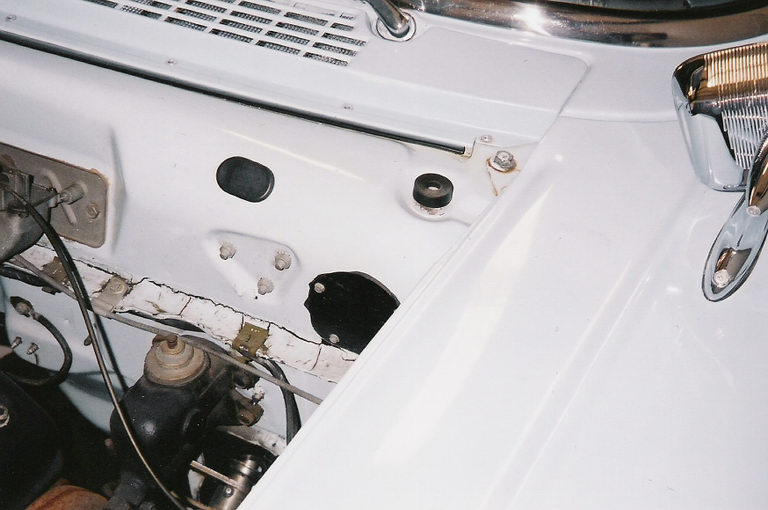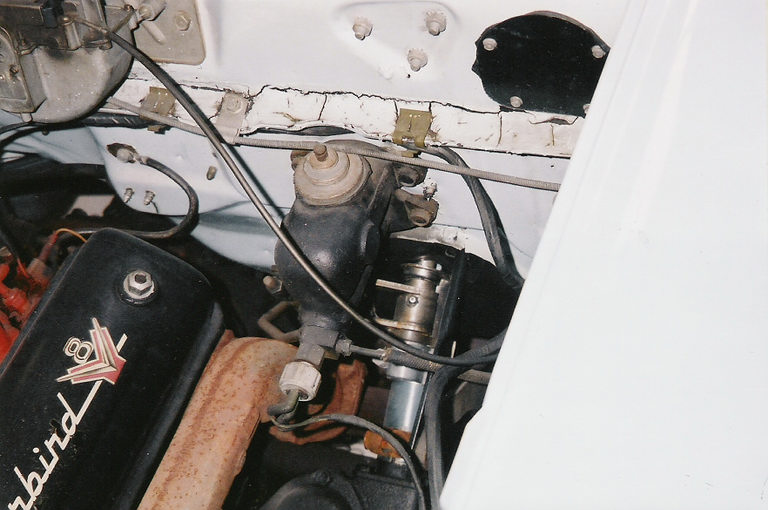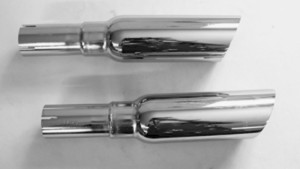The Gemma Jackson Club Victoria
History:
Right after I purchased the Vicky, I discovered a few minor problems: Mike Smith pulled the steering column (to correct a balky column-shift linkage problem to the three-speed transmission), the engine needed to be tuned up, the front brakes were worn out, and the radiator was plugged with crud (it was boiled out/and refilled). I also pulled the front seats out so I could remove the factory carpets and have them cleaned. The Holley 2-V carb was typically leaking (Holleys ALWAYS LEAK) and was rebuilt twice before the 2013 engine tear down. After the car was then drivable, and my wife, Janet, and I enjoyed the car a bit from 1990 through 1996 whereupon it went into storage when my free time evaporated. Our oldest son, Eric, drove the car a bit, too.
When I had the chance to look over a considerable collection of factory promotional documents and ephemera, I uncovered the history of the car. I discovered the full range of the remarkable background to the car: a diary, decades of repair documents, and a large quantity of paper ephemera that the dealer passed on to me. I must have spent a week sorting through many dozens of documents and discovered a remarkable history that may be nearly- unique among all vintage cars. And I came to “know” the remarkable first owner of the car – Gemma Jackson – through that written history. Apparently, the Libby Food company hosted a nationwide contest, in 1956, to award a 1957 Ford Victoria to the successful writer of a promotional jingle for that company. Such contests were somewhat common in the Fifties.
A Salt Lake City woman – Gemma Jackson – was the national winner, and the Ford was awarded to her. She received a Western Union telegraph,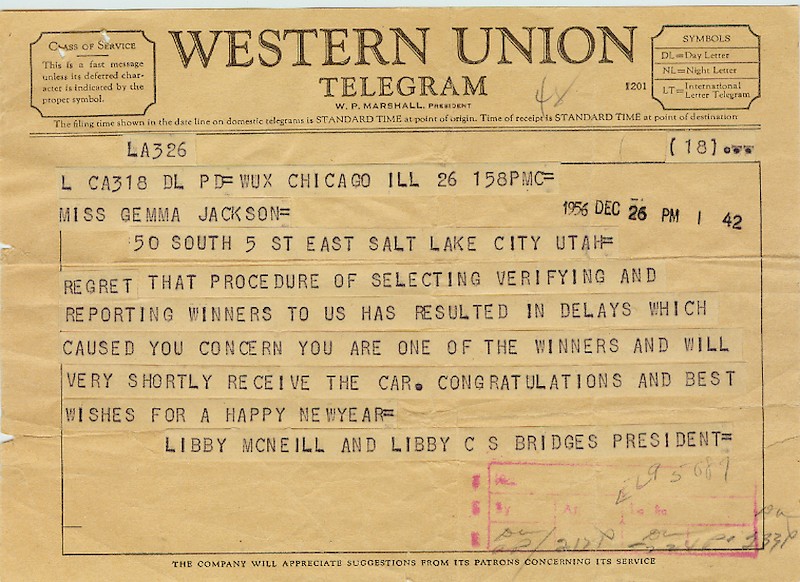
announcing the award of the car to her; the Vicky arrived at the Salt Lake City International Airport on a United Airlines cargo jet sometime in very early 1957. Gemma apparently wrote to the company to express her appreciation for the car, and the company wrote back.
After I acquired the car, I searched the ‘Net and wrote to the new owners of Libby Food to gain more information about this contest; I first wrote (in a letter dated January 2, 1995 which was really 1996) to “Libbys” (not knowing the proper name of the company)
and got a quick and gracious reply on January 11, 1996,
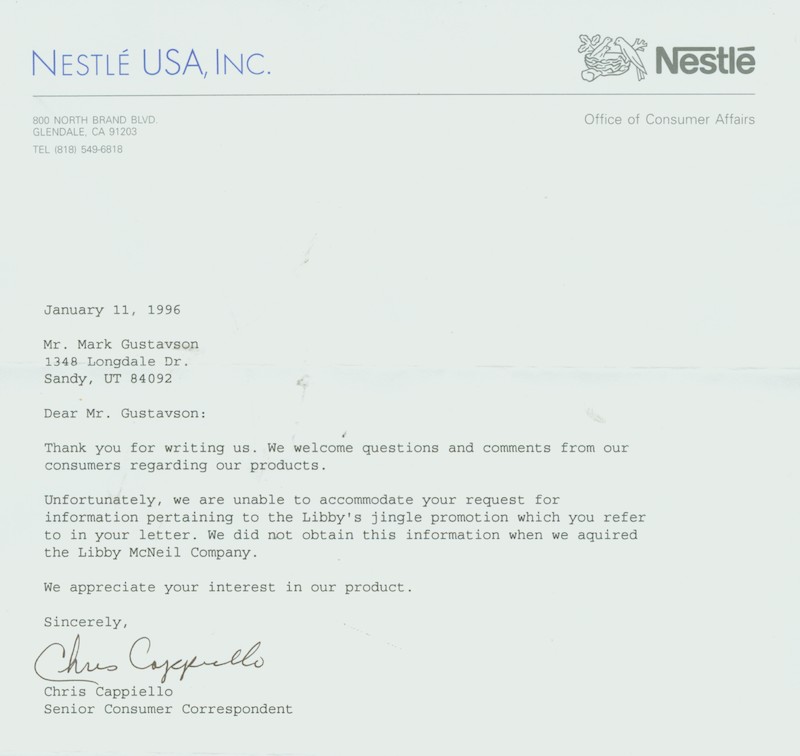 in response, indicating that Nestle USA, Inc. now owned the Libby company, and that no information on the late 1956 give-away existed. Not being content with that letter, I wrote again to the new name of the company (Nestle USA, Inc.) on January 16, 1996
in response, indicating that Nestle USA, Inc. now owned the Libby company, and that no information on the late 1956 give-away existed. Not being content with that letter, I wrote again to the new name of the company (Nestle USA, Inc.) on January 16, 1996
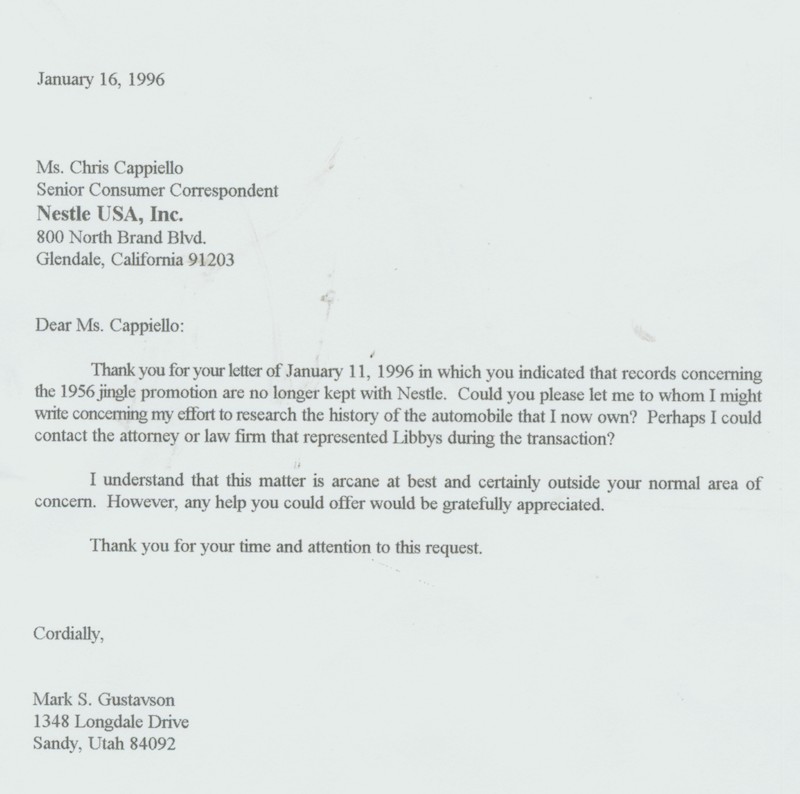 and received another reply from Nestle on March 1, 1996.
and received another reply from Nestle on March 1, 1996.
Clearly, that was the end of that research avenue. Subsequently, I have searched the ‘Net and haven’t been able to uncover any further information on that 1956 contest. Apparently, the only evidence that remains of that contest are the artifacts that came with the car.
Gemma cared for the car until her death in the early Eighties. To say that she “loved” the car would do her a disservice – in fact, Ms. Jackson was passionate about the Vicky and cared for it in ways that bordered on obsessional. The car was regularly washed and waxed by someone at a selected service station in Salt Lake City. The Vicky was apparently never driven in the snow: I’ve discovered no scale rust in any of the usual places underneath giving evidence to her handwritten notes that she didn’t drive the car in the winter. The car was serviced by the legendary (now closed) Bennett Ford in Salt Lake City, initially, whenever even the most minor problem arose; the factory protective shipping clear plastic seat covers were only removed after many years.
Moreover, Ms. Jackson’s notes on the Bennett Ford invoice – – in which she called the woman who damaged her car a “bitch”, a strong word for a woman to use as the Fifties ended – – give evidence of her devotion to her car. That outburst gave a face to her anguish to the replacement of the rear bumper with a factory-authorized replacement. She had even small items taken care of promptly; the oil was changed about every thousand miles – – Mike Smith reported that the engine’s internal surfaces were very clean when he rebuilt the engine!
Cynics might too-casually observe that Ms. Jackson was over-the-top in her care for the car, but her devotion and great maintenance procedures have delivered to the future an exquisitely authentic and original factory car in generally great condition. I wish I had known Gemma –we might have become friends given our mutual interest in, and dedication to, this great car.
You might enjoy checking out the following photo essays that show the car before my crew and I started any restoration (and modification) work at all.
Restoration and Modification of the Gemma Jackson Victoria
In January of 2013, I decided it was time to move forward this multi-faceted 1957 Ford Victoria Project and that the first step was the restoration, and mild modification, of the car which included the renewal of the engine disassembly of the front clip. The Vicky was in basically great condition, but the engine compartment and under carriage were an incredibly dirty mess (lots of grease with embedded dirt), and the engine had developed some troublesome noises deep in the block. And there were a few other problems, too: the lower bolster on the driver’s seat had been cut at some point in the past, the inside cowl kick panels were damaged, and the whole car needed to be seriously tidied up: The car needed significant renovations to make it visually presentable and mechanically reliable. But there was NO cancer rust to fight anywhere – a tribute to Gemma’s loving care of her car. Because of the decision to entirely disassemble the front clip to remedy the greasy and generally dirty condition of the car, the whole revival process turned out, surprisingly, to be more complex and labor/dollar intensive than I had planned at the outset. The goal, also, of significantly modifying the engine for improved performance also consumed a lot of time and, some unexpected costs, especially since it was not my original intention to modify the engine..
As noted previously, to fix the engine problem and make the car aesthetically presentable, I decided that we would need to pull the engine and transmission, drop the entire front suspension, and also remove the entirety of the front sheet metal clip including inner engine compartment panels, radiator support and related parts. With these parts removed, we could satisfy the goal to rebuild and modify the 292 V8, update the suspension to front disc brakes (the factory brakes are awful and scary), and show-detail the car.
Satisfying these goals would also give me access to the actual information (images and measurements) necessary to build the several scale miniature Victoria (link to Page Six) for this Project: with everything disassembled on the front of the car, parts and shapes could be measured for the sake of miniaturization.
Because I’ve had a fantasy about ‘57 Fords since I was a little boy (we’re all “prisoners of our childhoods,” I believe), I decided to commit the ultimate heresy and modify my Vicky despite its unique history.
The modifications to the Jackson Vicky will proceed along these lines:
Mechanical:
- Front spindles from a 1978 Lincoln Versailles which will drop front end by almost two inches. The spindles will accept Granada rotors, pads and calipers;
- Engine bored .30 and fitted with Sealed Power 9:1 forged pistons;
- Heads port matched to Mummert intake with lots of bowl work;
- Heads port-matched to the prototype Sandersen headers;
- Hardened valve seats;
- “Blower” cam specially-machined (from a NOS billet cam) made by famed cam grinder Chris Nelson (who got his start working for Isky),
- Mummert medium-rise aluminum intake; Link to http://www.ford-y-block.com/
- 1958 1.19 Venturi Ford 4150 carb – originally used on a Mercury 383 Marauder: a rare, rare and very cool carb;
- Custom-made tubular headers – we have acquired THE prototype set built by famed cam grinder Chris Nelson for Sanderson’s Headers. Here’s a photo of the raw header (before being aluminum sprayed) straight from Chris’ shop; (Photo: Modified 9)
- 1-1/8″ aftermarket sway bars will be mounted front and 1″ sway bar mounted to rear axle – the car’s factory handling is frightening;
- Single loop cut from the front coils which will not only modestly lower the car but also result in a stiffer spring;
- Heavy Duty Koni Shocks front and rear; and
- 1″ lowering blocks installed on rear axle
Exterior Aesthetic:
- American Racing Torque Thrust five-spoke wheels;
- Reproduction 1967 Shelby Mustang 350 exhausts tips will be moved up into a flare cut into the bottom of the rear bumper – – which will need to be re-plated.
- Seams on front fenders closed by welding;
- Scripts removed from front fenders and panel between headlights;
- ‘57 Hood “gunsight” removed
- Delete exterior radio antenna;
- Removed door handles and locks; and
- Removed trunk emblem.
Engine Compartment:
- Inner fender panels/radiator support/hinges/miscellaneous panels powder coated gloss black;
- Firewall resprayed body color;
- Stainless bolts used throughout;
- Metal sprayed prototype Sanderson exhaust manifolds;
- Selected chrome plating on engine parts: valley cover, oil fill tube, oil pan, pulleys, lots of small parts. Here’s an image of the engine ready to get dropped into place: Photo: Modified.20
- Suspension pieces powder coated. Here are the front suspension pieces back from the powder-coater:
Interior:
- Tachometer, in cup, mounted atop the dash speaker grille;
- Three-gauge panel beneath dash;
- Front seat to be recovered in factory materials (cloth and vinyl) sourced from SMS Fabrics in Oregon.
